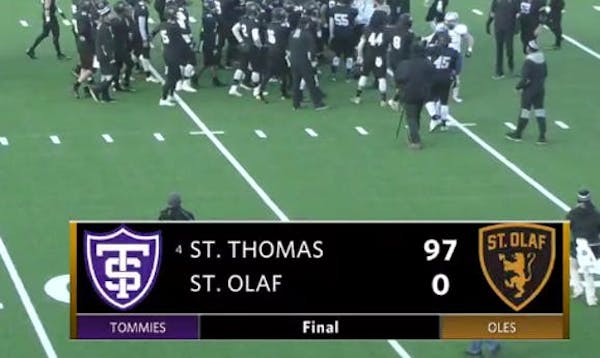Over the past two weeks, news that St. Thomas could be expelled from the MIAC has raised plenty of questions. Will the Tommies really get booted from a conference they helped found 99 years ago? Should they move to Division I? If they go, what happens to the annual football showdown between St. Thomas and St. John's?
While there are no answers yet, there is no shortage of speculation. The Star Tribune reported on April 5 that presidents of the 13 MIAC member schools would meet Thursday to consider a bylaw change, which would effectively push St. Thomas out. The effort has been shrouded in secrecy; neither the league nor its schools publicly acknowledged it until Wednesday, when St. Olaf issued a statement saying it is "engaged in a discussion of membership."
According to the Star Tribune report, the movement to eject St. Thomas is rooted in its size — it has about twice as many undergraduates as St. Olaf and Bethel, the next-largest MIAC members with football programs — and its athletic dominance, particularly in football. Sources said those wishing to boot the Tommies will try to convince the MIAC to adopt an enrollment cap, at a level that would exclude St. Thomas. The school's current undergraduate enrollment is 6,199.
League bylaws state that any membership termination must be approved by at least nine of the member schools, with voting by secret ballot.
MIAC Commissioner Dan McKane said Wednesday he cannot comment on the discussions, a response echoed by several school officials as well. In a written statement, St. Olaf spokesman Mike Ludwig would only confirm that talks were happening.
"Membership in the MIAC is determined by the member institutions," it said. "St. Olaf, along with the presidents of all of the MIAC institutions, is engaged in a discussion of membership. We are participating in those discussions in good faith, and we await the results."
St. Thomas, though, has made it clear it has no plans to leave the league — or Division III — voluntarily.
"As a founding member of the conference, we are proud of our history and heritage in the MIAC, and are committed to the league values and D-III ideals," Tommies athletic director Phil Esten said in a statement issued Monday. "We are very interested in doing what we can to stabilize conference membership now and into the future."
The potential ouster has generated days of lively discussion on message boards and in comment sections. A Star Tribune unscientific poll drew almost 2,600 votes, with 56% saying the Tommies should stay and 44% favoring their removal. In a poll on the D3sports.com football chat board, 60 of the 75 voters picked the options supporting St. Thomas' continued membership.
If St. Thomas' enrollment is driving the effort to kick it out of the MIAC, it is unclear why that has become an issue now. The school has had about 6,000 undergraduates since at least 2010, though total enrollment has grown to 10,035.
It also has a long history as an athletic powerhouse, sweeping the MIAC's men's and women's all-sports championships in each of the past 11 years. Tommies football, which rose from mediocrity to national prominence in the past decade under coach Glenn Caruso, has come under fire from some league members for lopsided margins of victory against lesser teams. The Tommies defeated three MIAC opponents by 60 or more points last season, though St. John's also beat four league foes by 50 or more.
The potential MIAC mutiny has revived calls for St. Thomas to move up to Division I. But school officials still believe in the Division III philosophy, and making the leap would be a long, costly haul.
NCAA rules prohibit D-III schools from jumping directly to Division I. They must first move up to D-II, and the required transition periods make it at least a 12-year proposition to get to D-I. St. Thomas' athletic budget would have to grow sharply; according to the NCAA, the median operating expense for D-III football schools was $3.6 million in 2015, while that figure was $17.3 million for a D-I Football Championship Subdivision school.
MIAC bylaws say the league can review the membership status of any member institution at any time, for any reason, under the direction of the Presidents' Council. A section on expulsion, added in May, lists violation of bylaws, failure to pay dues, failure to comply with scheduling requirements and "any action or inaction which reflects poorly upon the reputation and integrity of the Conference" as reasons for termination.

![University of St. Thomas head coach Glenn Caruso celebrated with his team after the win. ] ANTHONY SOUFFLE • anthony.souffle@startribune.com Ga](https://arc.stimg.co/startribunemedia/5MVTN272QZ44OO4ZHIAUDDZX6A.jpg?w=600&h=600&auto=format%2Ccompress&cs=tinysrgb)